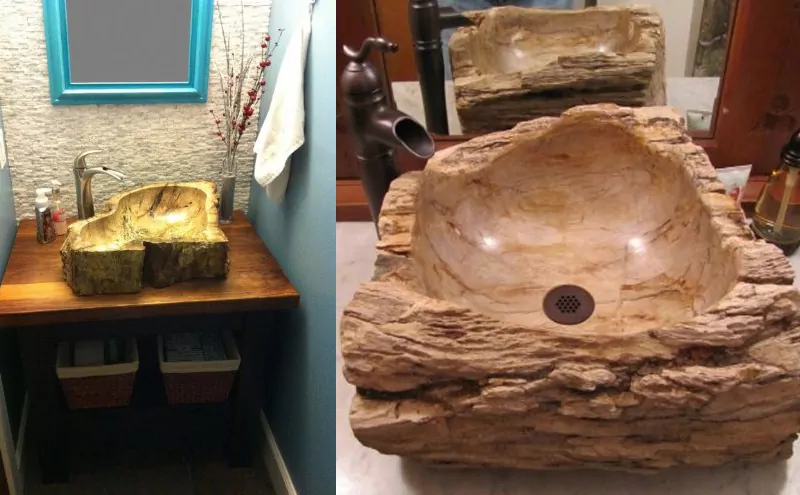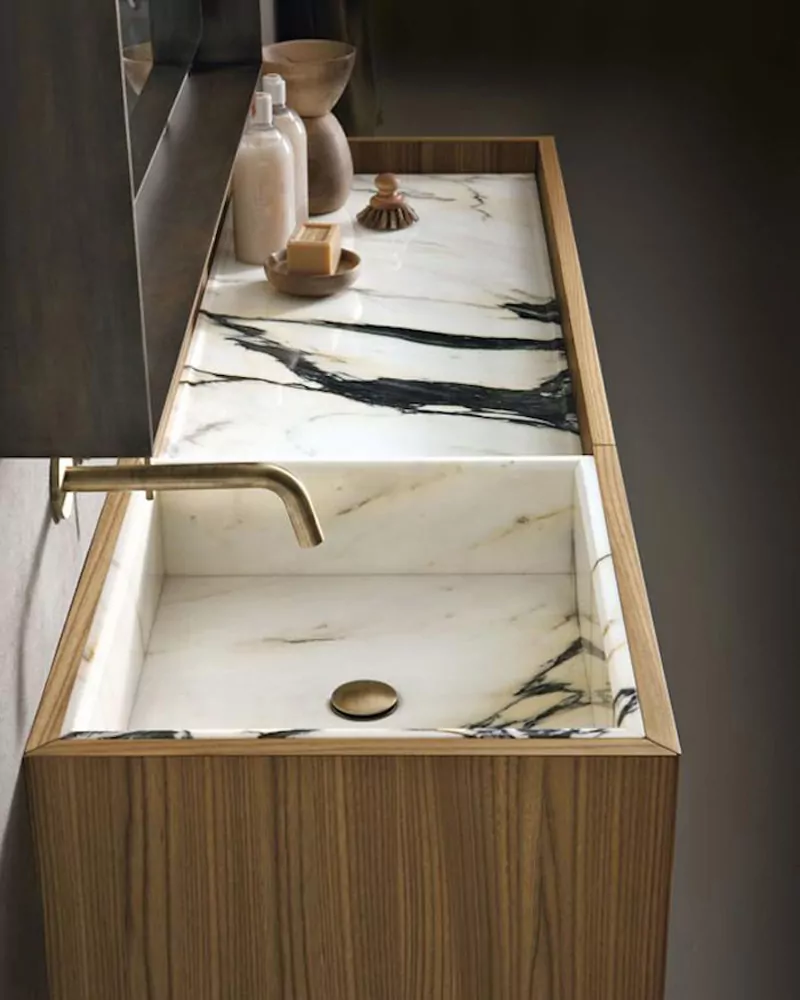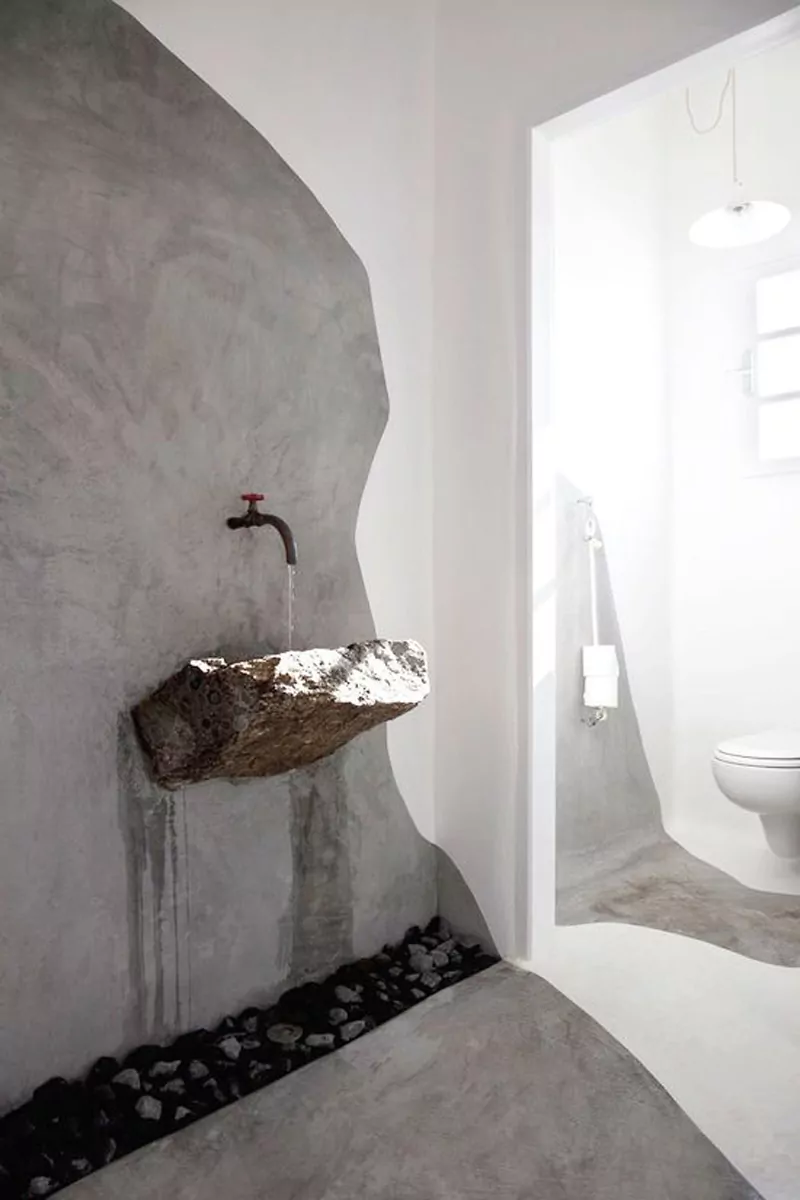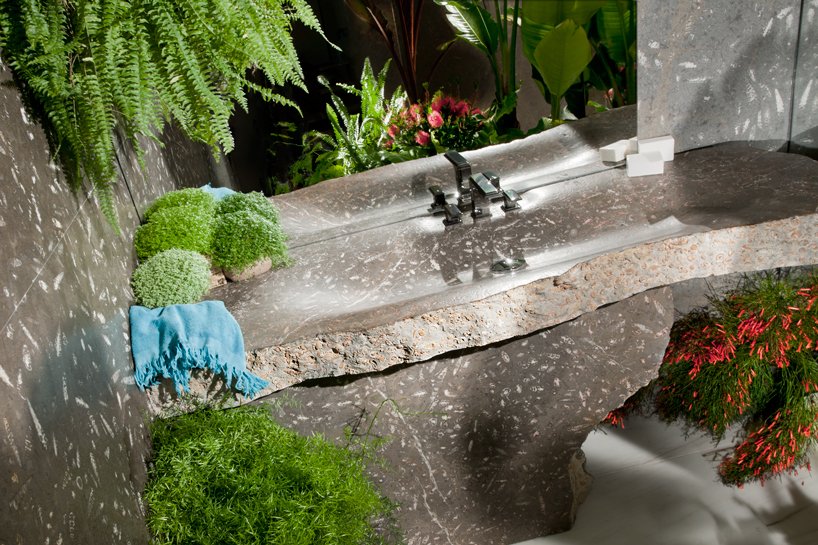In any home, the source of water tends to become a big focal point of the space: people naturally gravitate to running water.
In any home, the source of water tends to become a big focal point of the space: people naturally gravitate to running water. How often have you entered an unfamiliar building and immediately wondered where the restroom is, or likewise toured a new place to live and instantly gravitated towards the kitchen? Because of this, stone sinks can be an important stylistic and functional centerpiece of a house, especially if it is well-invested in with its visual aesthetic, a professional placement and installation job, and its natural stone durability. With strong plumbing and water, the simple function of a stone sink doesn’t have to play second fiddle to its visual and tactile design. The straightforward use of a sink means that its artistic style can come forward and take center stage, and with the modern technology of indoor plumbing can be taken for granted as we focus on the historic art that is stone sculpture.
Like its washroom counterpart the bathtub, which has an equally complex and in-depth catalogue of design choices, the stone sink can be constructed from a wide variety of natural materials in a dazzling array of styles, and no matter how creative or unique your interior design, you can always find a corresponding sink style that will match it perfectly and fit right in! And luckily for everyone, there is an endless array of styles, shapes, sizes, and materials to choose from. Between this wide selection and the multitude of other questions surrounding the selection and installation of these artisan sinks, it may feel a little bit overwhelming. Luckily, we’re here to help, with a small sample list of different sink varieties, as well as some frequently asked questions.
Ask five different people to think of a washroom sink, and you’ll probably get five different examples. Furthermore, ask five different people to think of an artisan sink, hand-crafted by a gifted professional stoneworker, and you’ll get five new examples that are even more widely varied! The good news is that this versatility is a reflection of the sheer size of options on the market today: you will be hard-pressed to imagine a stone sink style that neither exists nor can be custom made to order by a sculptor. Many such varieties are ones we offer: some are offered by other vendors. All of them can be customized and built to the specifications unique to your project.
The most common variety of sinks, made of stone or otherwise, is the common bowl-shaped basin. Referred to as a “vessel sink,” its structure is generally built separate from the apparatus it is being installed in, as opposed to being built directly into the countertop. This variety is about as flexible as you could expect of such a classic design, and can be made of any kind of stone for a large array of purposes and styles.

(Check out: Contemporary Sandstone Bowl Sink)
With its swirling patterns of natural color veins set against the smooth beige of sandstone, this contemporary river wave pattern sink will add an instant sense of sophistication to any space it is installed in. The sink’s smooth, polished bowl shape has been carved by hand from solid sandstone, retaining the natural beauty and durability of the stone mined straight from the earth.

(Check out: Granite Bowl Sink)
At a strong contrast to the gentle and earthy tones of the sandstone basin, this pure black granite sink is slick, shiny, and powerful. It has an inspired half-chiseled design, with rough, unrefined stone holding aloft the glass-like polish of the sink bowl like a cradling hand.
Perhaps just as common, but more contemporary in its quality, is the long sink, sometimes called the square sink in reference to its polygonal rectangular shape. It is not as traditional as the vessel sink, but it has exploded in popularity with the rise of modern porcelain materials and indoor plumbing technology. However, classical traditions are very easily blended with these recent stylistic developments: using marble and sandstone for these designs produces the best of both worlds, past and present.

(Check out: Black Marble Unique Design Double Sink)
The juxtaposition of rough and smooth edges on this Nero Marquina black marble sink is particularly dramatic, as it seems to resemble natural breakage rather than a more artificial looking combination of the two styles. The basins themselves are traditional vessel sinks inset on the rough patches as if someone miraculously scooped the unyielding stone out of the counter to make way for the small black marble basins.

(Check out: Modern Black Limestone Sink)
Streamlined, elegant, and deceptively simple, there are many different qualities that come together to make this black limestone rectangular sink work. The design would fit in perfectly with any contemporary bathroom, thanks to its universally attractive jet-black color and its straightforward geometry. Clean lines, stripped-down visual design, and a hard stone polished finish make this natural stone sink a perfect union of form and function.

(Check out: Modern design rectangular stone sink)
Bold and bright, this sandstone sink top features natural river wave coloration patterns, as well as plenty of space for both the sink and the surrounding countertop. As both a striking visual centerpiece and a cleverly designed sink top with its bottom surface slanting downwards to minimize splashing and mess, this is a vanity top sink that can fit in to all kinds of bathroom décor styles.
As beautiful and often practical as they are, the longer countertop sink designs come with their own list of potential shortcomings: they are, of course, some of the largest and most space-consuming varieties of sinks on the market. If you enjoy that visual style but would like something a bit smaller, akin to the more compact designs of vessel sinks, try simply cutting down the proportions!
With a few of the same visual cues as the more modern rectangular vanity top sinks, but taking a design regression back to a more traditional look, square slab sinks (which are truly square, and not just in name like some rectangular sinks are) combine the versatility and relative mobility of basin vessel sinks with the smooth, precise geometry of vanity top sinks.

(Check out: Wave Design Square Stone Sink)
Typically, we associate square designs with hard edges and sharp geometry, but that doesn’t always have to be the case! Consider the smooth, gentle corners of this smooth beige sandstone sink. It is a solid, unyielding piece of expertly carved natural stone, but it is also gracefully shaped and as elegant as the very water that runs into it!

(Check out: Wave design white marble square sink)
Pure, gentle silver color and an appropriately clean marble pattern makes this small stone sink one of the most spotless marble designs available. Smooth edges and corners, and a lack of substantial veining, might be a bit bland for a larger vanity top sink, but for such a small square, it provides a refreshingly clear spot in an otherwise fanciful roster.

This dazzling vessel sink design is made of petrified wood, which ingeniously combines the rugged, layered look of wood with a natural stone material. Petrified wood is essentially fossilized, with stone sediment slowly replacing the organic material of the deceased tree over the course of thousands and thousands of years. The result is essentially a wooden sink without the shortcomings of real wood material.

Swirling black and white marble inset into a rectangular wooden cabinet is the main building block of this natural stone sink. With a small lip of wood around the marble to prevent water from spilling out, this marble sink is ideal for washing dishes without making a mess, or for cleaning and preparing many ingredients without anything spilling off the sides.

Surely one of the most intensely rugged and aesthetically unrefined sinks on the market, this undeniably stone sink powerfully stands against the more conventionally smooth surface of the washroom wall, the rustic metal faucet above adding to the raw visual style, capped off with artistically considered water stains resembling a natural streaming creek.

On the other side of the natural rough rock style is this smoothed trough style sink inset into a wall setup installed snugly into the corner of the room. With the thick stone edge unpolished for a side of roughened naturalism to offset the glasslike smooth surface of the trough, it’s the perfect balance of artistry and ruggedness.

A pleasantly thick slab of creamy white marble settled onto a rustic wooden table with twin sinks, the vanity top’s smooth rounded surface is comfortable and practical, perfect for facilitating the flow of water both within the sink bowls and across the counter for cleaning.

Arguably the opposite of the previous two designs, this stunning metal sink has its raw, natural stone elements as its pedestal, rather than the sink itself. The design is deceptively minimalist, but the stark contrast of texture, with the sink’s hard sheen and the stone’s rugged crags, give a much greater sense of dynamism than the design would suggest.
We’ve talked quite a bit about the duality of aesthetic and utility in these stone sinks, and while the visual style and design of your choice is wholly a matter of personal preference, there remains an entire slew of practical factors to consider, such as maintenance, durability, cleaning, and all manner of other elements that you might not immediately think to consider when swept up in the passion of choosing a beautiful stone sink. Here we consider seven important questions to think about before confirming your selection, some of which may be obvious to dwell upon, some maybe less so.
Our first question concerns the durability of stone sinks: are they as tough as they look? Luckily, they are! The typical stone materials of stone sinks, such as granite, marble, and limestone, are all formed deep in the earth, under unimaginable levels of heat and pressure that compress them into powerfully compact and layered deposits. Compared to those conditions, years of normal use and a constant stream of hot water is next to nothing for these furnace-forged fortresses!
Can stone sinks be stained? The answer is a resounding (and unfortunate) yes! Trace metals and minerals common in tap water and water pipes accumulate on the stone surface, and the stone’s natural pores can provide frustrating pockets for these build-ups to seep into over long periods of unwashed use. But on the bright side, it’s not too difficult to prevent these stains from happening, or to wash them off when they do.
Perhaps the most realistic threat to a natural stone sink is mineral deposits and staining. So how do you care for a natural stone sink? The answer is simple, yet for the best possible maintenance of your sink, you must be diligent with these simple cleaning practices. The most important thing is to avoid abrasive materials: normal gentle dishwasher soap works best, as it does not contain any strong acids, alcohols, ammonia, or any such pungent cleaning chemicals which would wear away at the surface of the stone. It is also important to rinse the soap away thoroughly when done washing, as accumulation of dried suds can be just as detrimental as the hard minerals we are washing away in the first place.
So after all this talk about variety… which type of sink is best for a bathroom? Even beyond the wide array of natural stones available on the market, there are still tons of options to choose from. A common material for sinks, for example, is stainless steel, which has its own list of pros and cons. The most obvious strength of stainless steel is its resistance to rust and mineral deposits. However, such sinks are ultimately better for kitchens than for bathrooms. Woods such as teak or bamboo (which is a grass very similar to wood in strength and texture) are also common. However, the final answer for the best type of bathroom sink would have to be marble. For its visual beauty, its natural strength, and its ease of maintenance and cleaning, marble can’t be beat.
Granite is also a very common type of sink. Are such granite sinks better than stainless? For the same reasons as marble, the answer is yes. Stainless steel is far less durable than granite, and more vulnerable to scratching and wear over time. This is why it is so much cheaper. Granite, meanwhile, is for all intents and purposes eternal, as long as rudimentary maintenance and cleaning is performed every once in a while.
Do marble sinks remain the king of washroom sink materials? In the final analysis, this is almost always true: marble is very often the best material for sinks, bathtubs, fountains, and other appliances for running water. Perhaps the biggest reason for this strength is marble’s wholeness: it comes in large, uninterrupted slabs, without any breaks or seams. A single solid piece of carved, polished stone is formidably strong and resistant to staining and cracking.
Now with so many positive qualities, how much does a marble sink cost? Generally, marble slabs are priced by the square foot, typically around forty to one hundred dollars per square foot, and a reasonable estimate for a common bathroom sink would run at around five hundred to one thousand dollars in total, depending on the size and design of the sink, including whether it’s a vessel sink (a common bowl or similar structure) or a vanity top (a sink inset in a wider counter).
So what about repairs? How do you repair a marble sink? If the marble material is genuine natural stone, then most chips, stains, or burns on the surface can be cleaned and smoothed over with a hand polish machine. Marble countertop cleaning products can be bought from any local home improvement stores. However, a sink made of cultured marble cannot be cleaned with such straightforward means. Cultured marble is a marble stone mixture, usually blended with a polyester resin, which can make it more durable and less porous, but also more difficult to clean and maintain.
Since marble counters and sinks are always made from solid, unbroken slabs of pure stone, a substantial amount of material is needed to build pretty much anything. A marble vanity top would need enough natural stone for the sink, the surrounding countertop, and any supporting structures that anchor it to the plumbing, wall, or whatever layout you have decided on.
So how heavy is a marble vanity top? Marble stone is weighed by its square footage. In general, marble stone can be anywhere from six to seven pounds per square foot, to as much as twice as heavy. On the light side, this means that an average marble countertop containing about thirty square feet of solid marble stone would weigh approximately two hundred pounds, and it is not unheard of for such fixtures to weigh as much as four hundred or even five hundred pounds. This is why professional installation and floor and wall reinforcement is often a must for such products.
Ultimately, there are no right or wrong answers. To each designer or homeowner, their favorite selection will feel like the correct one, on a factual level. But really, the subjectivity never goes away, and the beauty of the individual shines through with the selection no matter what design rules your sink choice follows or breaks.